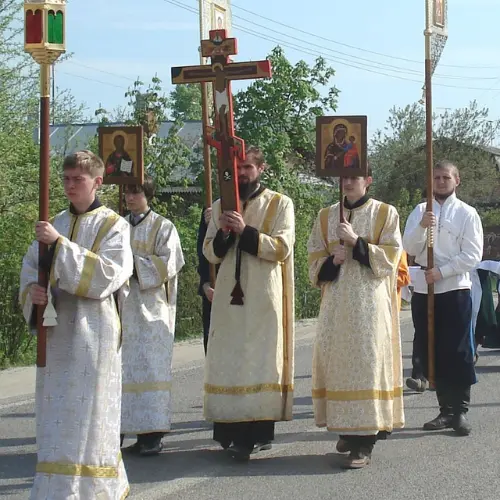.png)
The Russian Orthodox Cross, with its distinctive three-bar design, stands as a powerful symbol deeply rooted in the history and traditions of the Russian Orthodox Church. This cross not only serves as a religious icon but also encapsulates a rich tapestry of symbolism, reflecting the spiritual beliefs and cultural identity of the Orthodox Christian community. In this exploration, we delve into the origins, design, and profound meanings associated with the Russian Orthodox Cross.
Origins and Design
The Russian Orthodox Cross, also known as the Orthodox Cross or Byzantine Cross, is characterised by its unique three-bar structure. Unlike the more familiar Latin Cross with two intersecting bars, the Russian Cross features a third horizontal bar, slanted diagonally, positioned above the intersection of the vertical and horizontal bars. This design is symbolic in itself, representing the inscription placed above Christ's head during the crucifixion, as mentioned in the Bible.
The horizontal bar at the top is often inscribed with the acronym "INBI," representing the Latin words "Iesus Nazarenus, Rex Iudaeorum," which translates to "Jesus of Nazareth, the King of the Jews." This inscription serves as a reminder of the accusation written by Pontius Pilate and emphasises Christ's kingly status even in His suffering.
The three bars of the Russian Orthodox Cross carry distinct meanings:

Top Bar (Titulus): This bar represents the inscription mentioned earlier and signifies the authority of Christ as the King of Kings. It is a visual declaration of Christ's divine sovereignty.
Middle Bar (Crossbar): This bar symbolises the cross on which Jesus was crucified, providing a direct connection to the central event of Christian salvation. It represents the intersection of the divine and human realms.
Bottom Bar (Footrest): The slanted bar at the bottom is often interpreted as the footrest, a unique feature of the Russian Cross. It symbolises the support provided to Christ during His crucifixion, reinforcing the idea that His suffering was not borne alone.
Symbolism
The Russian Orthodox Cross is laden with symbolism, each element carrying profound religious significance for Orthodox Christians. The unique design and elements incorporated into the cross convey a deeper understanding of the Orthodox faith and its theological teachings.
Triumph of Christ over Death: The three-bar design of the Russian Cross is believed to represent the Holy Trinity—Father, Son, and Holy Spirit. It symbolises the victory of Christ over death and sin, highlighting the central tenet of Christian theology—resurrection and eternal life through Christ.
The Suffering of Christ: The slanted footrest on the Russian Cross is a distinctive feature not found in other Christian cross designs. It is a poignant reminder of the suffering of Christ on the cross. The footrest signifies the added discomfort and agony endured by Jesus during His crucifixion, emphasising the depth of His sacrifice for humanity.
Connection to Tradition: The Russian Orthodox Cross serves as a powerful link to the historical and cultural traditions of the Orthodox Christian community. It reflects the continuity of the Orthodox faith and its adherence to the teachings passed down through generations.
Spiritual Warfare: The three bars can also be interpreted as representing the spiritual battle between good and evil. The vertical bar symbolises the divine realm, while the horizontal bars signify the earthly and underworld dimensions. The Russian Cross, therefore, becomes a symbol of spiritual warfare and the ultimate triumph of God's kingdom.
Cultural and Historical Significance
Beyond its religious symbolism, the Russian Orthodox Cross holds cultural and historical significance within the broader context of Russian Orthodoxy. It has been an integral part of the visual language used in religious art, architecture, and traditional artefacts throughout the centuries.
Iconography and Religious Art:

The Russian Orthodox Cross is a recurring motif in religious art, particularly in the creation of icons. These sacred images play a crucial role in Orthodox worship, serving as windows to the divine. The cross, often depicted with intricate details and vibrant colours, becomes a focal point in these representations, emphasising its importance in the religious narrative.
Architectural Representation:

Russian Orthodox Churches showcase a unique architectural style, merging Byzantine influences with Russian aesthetics. Characterized by iconic onion-shaped domes, intricate frescoes, and symbolic iconography, these churches embody a deep connection to the Russian Cross. Crosses embellish domes and exteriors, emphasizing the sacredness of these spaces, inviting worshippers to contemplate the mysteries of their faith. The prevalence of the Russian Cross on church structures serves as a continual reminder of Christian beliefs, both in exterior design and interior ornamentation.


Marvel at the awe-inspiring Church of Mary Magdalene, a Russian Orthodox gem gracing Jerusalem's Mount of Olives since 1888. Built by Tsar Alexander III and his brothers to honor Empress Maria Alexandrovna, the church, designed by David Grimm, showcases the traditional tented roof style of 16th- and 17th-century Russia. Its skyline is adorned with seven distinctive, gilded onion domes that gleam against the backdrop of the majestic tree line.

Dedicated to Mary Magdalene, the disciple of Jesus and the Apostle of the Apostles, this sacred sanctuary holds historical significance. According to the Gospel of Mark, Mary Magdalene was the first to witness Christ's resurrection, making her a pivotal and cherished disciple. The Church of Mary Magdalene stands as a testament to both architectural splendor and spiritual reverence, inviting visitors to immerse themselves in its rich history and breathtaking design.
Personal Devotion:

The Russian Orthodox Cross is frequently worn as a pendant or incorporated into religious jewelry by Orthodox Christians. This serves as a personal expression of faith and a constant reminder of the central tenets of Christian theology.
Religious Rituals and Symbolic Practices
Liturgical Use:

The Russian Orthodox Cross plays a crucial role in the religious ceremonies and liturgical traditions observed within the Orthodox Church. In the course of services, priests frequently bear processional crosses, and many of these carry detailed designs of the Russian Cross. These crosses serve diverse purposes within ceremonies, encompassing processions, blessings, and the veneration of sacred icons. This underscores the significance of the Russian Cross not just as a symbol but as an actively employed element in the ritual practices that define Orthodox worship.
Sign of Blessing:

The Russian Orthodox Cross is utilized as a powerful symbol of divine blessing. Whether invoked by a priest in the sacred context of a church service or worn as a personal adornment, the cross serves as a tangible reminder of divine protection and the profound spiritual significance embedded in one's faith. Among Orthodox Christians, there is a prevailing belief that making the sign of the cross possesses the inherent power to ward off evil forces and invoke blessings from God. This practice underscores the deep connection between the physical gesture of the cross and the spiritual beliefs and protective qualities associated with it.
In conclusion, the Russian Orthodox Cross transcends its role as a religious symbol to become a dynamic force that weaves through the fabric of Orthodox Christian life. From liturgical practices and architectural designs to personal adornments and family traditions, the cross serves as a bridge connecting the spiritual realm with the tangible expressions of faith in everyday life.
Its enduring presence in religious rituals, artistic expressions, and personal devotions underscores its significance as more than just a visual emblem. The Russian Orthodox Cross is a profound representation of the Orthodox Christian worldview, encapsulating the essence of the faith, its historical evolution, and it's deep cultural roots. As Orthodox Christians continue to draw strength and inspiration from this timeless symbol, the Russian Cross stands as a testament to the enduring nature of faith and the rich tapestry of traditions that define the Orthodox Christian identity.







